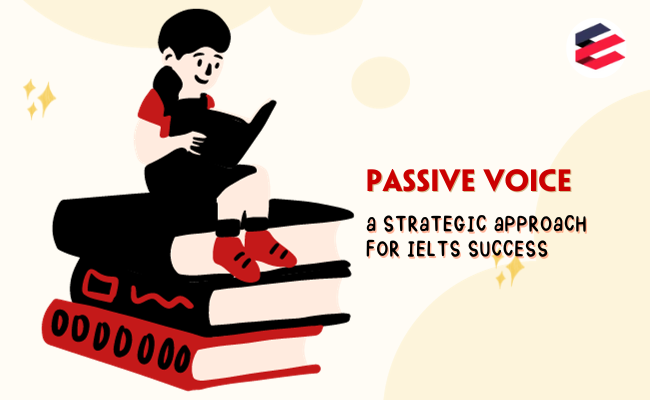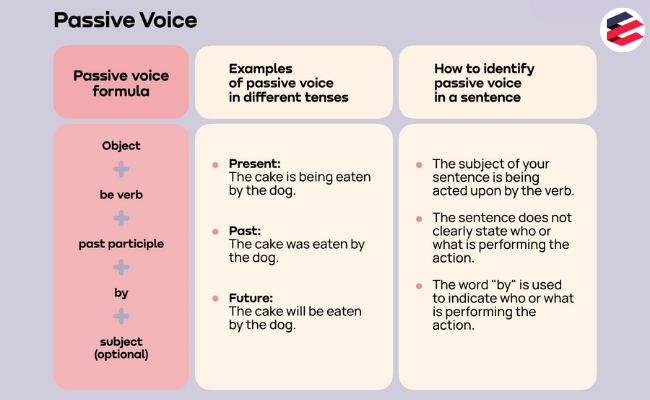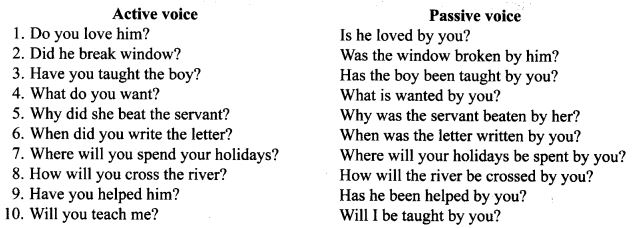Utilizing Passive Voice: A Strategic Approach for IELTS Success
Mastering the nuances of the English language is pivotal for success in the International English Language Testing System (IELTS). One such linguistic aspect that holds substantial importance is the passive voice. It is a construction that, when employed judiciously, can elevate the sophistication and effectiveness of our writing. In this essay, we explore the role of passive voice in IELTS, understanding its appropriate usage, and the impact it can have on achieving a higher band score.

1. Passive voice definition
Passive voice is a grammatical construction in which the subject of a sentence is acted upon by the verb, rather than performing the action. In passive voice, the focus is on the recipient of the action rather than the doer of the action.
Passive voice is used for various reasons, such as when the doer of the action is unknown, when the focus is on the recipient of the action, or when the speaker/writer wants to be less direct about who is performing the action. However, using active voice often leads to clearer and more direct communication.
2. What is passive voice rules?
2.1. Passive voice structure
In short, passive voice is an essential subject in English grammar in general, and as the grammar for IELTS, and holds significant value in English speaking and writing. The statements in English can be presented in active and passive voice. While the active voice is in the direct form, the passive voice is in the indirect form. Specifically:
- The object of the active verb will become the subject of the passive verb.
- The active sentence’s subject becomes the object of the passive sentence
- The form of the verb is changed to the past participle of V.PIII from
- The preposition “by” is used before the passive object
The structure of a passive voice sentence typically follows this pattern:
O (subject in passive voice) + be V (am, is, are, was, were, being, been)+ past participle of the main verb + (optional) by + agent
Here’s an example of the passive voice structure in a sentence:
- Active voice: “They are building a new house.”
- Passive voice: “A new house is being built by them.”
2.2. Passive voice tenses
When converting the active voice to the passive voice, remember to follow the guide below:
- The source in ‘by the’ or who or what is functioning must first be located.
- Once you have determined who is acting, make that individual the sentence’s subject
- The verb will then need to be adjusted properly
The table below shows you how passive voice is represented in different tenses:
| Tense | verb form | |
| active voice | passive voice | |
| present indefinite | does/do | is/are/am |
| present continuous | is/am/are | is/am/are + being |
| present perfect | has/have | has been/have been |
| present perfect continuous | has/have been | have/has been + being |
| past indefinite | did | was/were |
| past continuous | was/were | was/were + being |
| past perfect | had | had been |
| past perfect continuous | had been | had been + being |
| future indefinite | will | will be |
| future continuous | will be | will be + being |
| future perfect | will have | will have been |
| future perfect continuous | will have been | will have been + being |
>>See also: relative clauses

3. When do we use passive voice?
Passive voice is used in writing and speaking for various reasons and serves specific purposes. Understanding when to use passive voice is crucial for effective communication and conveying the intended meaning. Here are common scenarios when passive voice is used:
3.1. When the Focus is on the Receiver of the Action
Passive voice is used to emphasize the recipient of the action rather than the doer. This is useful when what’s being acted upon is more important or relevant than who is performing the action.
Example: “The cake was eaten by the children.”
3.2. When the Doer is Unknown or Unimportant
If it’s unclear or unnecessary to mention the doer of the action, passive voice can be used to shift the focus away from the agent.
Example: “The mistake was made.”
3.3. To Be More Formal or Objective
Passive voice can lend a more formal or objective tone to writing, which is often preferred in academic or professional contexts.
Example: “The report was reviewed by the committee.”
3.4. To Avoid Blaming or Assigning Responsibility
Passive voice can be used to avoid assigning blame or responsibility for a particular action, making it a softer way to express information.
Example: “Mistakes were made.”
3.5. In Scientific or Technical Writing
In scientific papers or technical documents, passive voice is commonly used to maintain objectivity and focus on the process or results rather than the individuals conducting the study.
Example: “The experiment was conducted using precise measurements.”
3.6. To Maintain Clarity or Smooth Flow
Sometimes, using passive voice can help maintain a smooth flow of information or clarify a complex idea by rearranging the sentence structure.
Example: “The new policy was implemented to address the issue.”
3.7. When the Doer is Obvious or Unnecessary Information
In some cases, the doer of the action is evident or unnecessary to mention, making passive voice appropriate.
Example: “The news was announced.”
3.8. In Literary Writing for Stylistic Effect
Authors often use passive voice for stylistic reasons, such as to create a particular mood, build suspense, or evoke emotions.
Example: “The treasure was hidden in the darkness.”
4. The passive voice for IELTS
In the IELTS Writing test, both Task 1 (which involves describing visual information) and Task 2 (which is an essay) may require the appropriate use of passive voice for effective communication and demonstrating a good command of English. Let’s explore how passive voice can be used in each task:
4.1. Passive voice in IELTS writing task 1
In IELTS writing Task 1, you are usually presented with visual data, such as graphs, charts, or diagrams, and you need to describe and interpret the information in a clear and organized manner. Passive voice can be used to emphasize certain aspects of the data and make your descriptions more cohesive.
- Emphasizing Data Trends: Passive voice can be used to highlight trends or changes in the data. For instance, “The number of cars produced increased steadily over the five-year period.”
- Introducing Key Data Points: Use passive voice to introduce important data points. For example, “It can be seen that a peak in energy consumption was reached in 2018.”
- Comparing Categories: Passive voice can help in comparing different categories or elements in the data. For example, “More bicycles are sold than scooters in this region.”
- Reporting Survey Results: When discussing survey results, passive voice can be used for a neutral and formal tone. For example, “According to the survey, the majority of respondents were satisfied with the service.”

4.2. Passive voice in IELTS writing task 2
In IELTS Writing Task 2, you are required to write an essay on a given topic, expressing your opinion, analyzing a situation, or discussing a specific issue. Passive voice can be used in various ways to enhance your essay’s clarity, formality, or impact.
- Formal Tone and Objectivity: Passive voice can be employed to maintain a formal and objective tone, which is often preferred in academic and formal writing.
- Discussing General Knowledge or Facts: Passive voice is suitable for presenting general knowledge, established facts, or well-known information. For example, “It is widely known that climate change is a global concern.”
- Discussing Problems and Solutions: Passive voice can be used to discuss problems and propose solutions, providing a structured and organized approach to your essay.
- Adding Emphasis: Passive voice can help emphasize specific points in your argument or discussion, drawing attention to the importance of certain ideas.
It’s important to use passive voice judiciously in both Task 1 and Task 2. Make sure to focus on clarity, coherence, and overall effectiveness in conveying your message or argument. Balancing the use of passive and active voice is key to demonstrating your language proficiency and achieving a high score in the IELTS Writing section.
5. Passive voice in IELTS exercise examples
These examples can help you practice recognizing and forming passive voice sentences, which could be beneficial for your IELTS preparation:
5.1. IELTS Writing Task 1 (Describing Graphs or Charts)
Exercise: Rewrite the sentence in passive voice.
Original: “The company sells a million units annually.”
Passive: “A million units are sold by the company annually.”
Exercise: Describe the trend using passive voice.
Original: “The number of books read by students increased steadily.”
Passive: “A steady increase in the number of books read by students was observed.”
5.2. IELTS Writing Task 2 (Essay Writing)
Exercise: Rewrite the sentence in passive voice for a formal tone.
Original: “People believe that governments should take action.”
Passive: “It is believed by people that action should be taken by governments.”
Exercise: Express a solution using passive voice.
Original: “We should recycle plastics to reduce pollution.”
Passive: “Recycling plastics should be undertaken to reduce pollution.”
In conclusion, embracing passive voice as a tool in our linguistic repertoire can significantly enhance our writing skills, ensuring clarity, coherence, and precision in our expressions—essential criteria for excelling in IELTS. By strategically incorporating passive voice, and tailoring it to suit the diverse writing tasks in IELTS, we pave the way for a seamless and impressive demonstration of our language proficiency. As aspiring candidates, recognizing the potential of passive voice and practicing its application can indeed be a defining factor in achieving our desired IELTS band score. In order to boost your IELTS score, take our IELTS online test now!